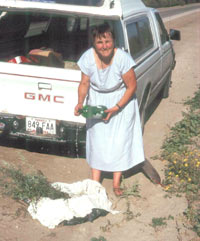Biogardener Homepage
with links to my other websites
Trees & Shrubs
Mother Nature's way
Getting Started Organically
start with the basics
Environmental Issues
legal and practical
Edible Garden
for food, drink & medicine
Traute Klein, biogardener
Webmaster's background & work
Allergy Lifeline
Natural help from personal experience
Biogardener Guestbook
Please Sign
or Read Entries
 Send me your own organic gardening story. Email me by clicking on the mailbox graphic. Send me your own organic gardening story. Email me by clicking on the mailbox graphic.
Related Articles
Willow, the Aspirin Tree, II
Willow as natural pain killer, floral preservative, and root stimulant. It isn't for everyone. Find out if it is for you.
Propagating Water-guzzling Hardwoods
Willow, poplar, and dogwood trees and shrubs can be started from cuttings, because they contain their own root stimulants.
Testing for Food Allergies
A simple and reliable test for food allergies. It has been used in Canada for at least 40 years, and it has never failed me.
Email from Heaven
Flight of fancy, involving my favorite tree, basswood. Award-winning personal essay of the month.

The above photo shows me preparing trees for transport home after digging them up in a ditch which is legal in Canada.
Amazon Books
Trees of North America
A Guide to Field Identification, Revised & Updated, Golden Field Guide from St. Martin's Press
More Tree & Pruning Books
|
Willow, the Aspirin Tree, I
by Traute Klein, biogardener
 Willow is the natural source of the painkiller which has become known as Apirin, or ASA. Willow is the natural source of the painkiller which has become known as Apirin, or ASA.
Let me tell you the history of salicylates and their effect on people, especially those who are allergic to them. Another article, linked in the left column, talks about the effect of willows on plants and gives some ideas of how we can take advantage of this effect even if we are allergic to ASA. Look for "Propagating Water-guzzling Hardwoods."
History of Salicylates
Aspirin may be the best-known pharmaceutical of modern times, but it is not new to herbalists. Natural salicylates have probably been used as painkillers since the stone ages. They are one of the oldest remedies, occurring naturally in trees, shrubs, and fruit. Their pain-relieving properties were known on both sides of the Atlantic. North American natives used them to for headache, fever, and lumbago. Europeans made a tea from the bark of white willow to cure pain. Hippocrates, the Father of Medicine, used a powder to treat pain, fever, the pangs of childbirth.
Allergy Caution
Before I ever heard the word "allergy," I found out the hard way that I am allergic to Aspirin. The first Aspirin which I swallowed not only did nothing for my headache, it made me hyper. A second pill did not alleviate the pain either, but it got me to climb the walls, so to speak. No one had to tell me that I should never try a third Aspirin.
When I enrolled in the high school woodworking courses at our local high school a few years ago, the first project involved the use of salix which is the Latin name for willow. The wood is soft and lends itself to being carved easily, but I was not prepared for its effect on my hands. At that time, I had no idea that willow contains salicylates. Within a day of handling the wood, two of my fingertips were stripped of skin. Before the week was out, all of my fingers burned and bled. The problem persisted until a couple of weeks after the completion of the project.
Sunscreens
A couple of years later, I participated in a pharmaceutical study on sunscreens. I considered the tests harmless, because I had been using sunscreens for years and had never had any problems with them. It seemed like an easy way to make a few dollars. No one informed me that the PABA of the original sunscreens had been replaced by salicylates. I had indicated on my application form that I am allergic to ASA, but no one paid any attention to that application form. As a matter of fact, I later found out that the staff administering the test had no knowledge of the ingredients of what they were testing. I saw some pretty horrific effects of the sunscreen on the backs of some of the other women guinea pigs, yet only one woman was pulled from the study. Some of the test areas were bleeding, others were highly inflameed, and the worst ones were oozing puss. If the affected women had been pulled, the agency would not have been able to complete the study and would not have been paid.
So let me warn you against pharmaceutical studies categorically. The administrators are not concerned about your welfare but only about the almighty dollar. That agency has done well financially and soon moved into a large new building of their own. The effects of the salicylates in those sunscreens on my skin will probably be with me for the rest of my life. I experience uncontrollable itching on my back where the test patches were applied, especially on warm days. You will find me leaning against posts or trees to scratch myself frequently, and I use a long-handled fork with me to scratch the spots. The dermatologist to whom I was sent ridiculed my reactions and tried to convince me that they were psychological.
So be careful with Aspirin or any other salicylates, including natural willow derivatives. If you are allergic to them, they are not for you. You can find an easy but reliable allergy test in the article "Testing for Food Allergies," linked in the left column.
When buying sunscreens, I carefully check the label to verify that the active ingredient is PABA which is a B vitamins. I have never heard of anyone being allergic to it.
Salicylates in Fruit and Food Color
To judge from my reaction to certain fruits, they contain varying amounts of salicylates. I am listing them in the order in which they give me problems. If you suspect that you or one of your children is having a hyperactivity reaction to these fruits, you can do your own allergy testing using the test in the linked article:
- Crabapples, especially raw
- Tomatoes, especially in tomato sauce and sundried tomatoes where the chemicals are more concentrated
- Strawberries, but only if I eat a lot of them after months of abstention
- Apples, especially if picked fresh off the tree
Let me also warn you that many food colors contain salicylates. I avoid them like the plague. Softdrinks, icecream, and candy give a double whammy to people allergic to ASA because the high amount of sugar intensifies the hyperactivity.
© Traute Klein, biogardener
-
|
 Send me your own organic gardening story. Email me by clicking on the mailbox graphic.
Send me your own organic gardening story. Email me by clicking on the mailbox graphic.